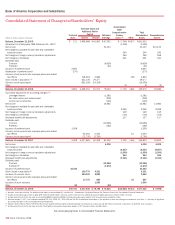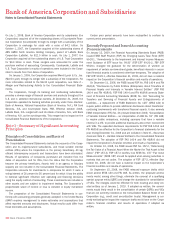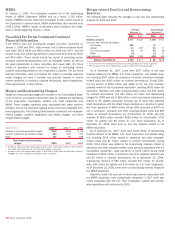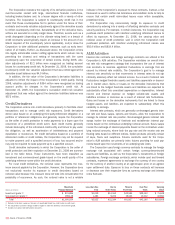Bank of America 2008 Annual Report Download - page 128
Download and view the complete annual report
Please find page 128 of the 2008 Bank of America annual report below. You can navigate through the pages in the report by either clicking on the pages listed below, or by using the keyword search tool below to find specific information within the annual report.continue to accrue on past due loans until the date the loan goes into
nonaccrual status, if applicable. Delinquency is reported on accruing
loans that are 30 days or more past due.
SOP 03-3 requires impaired loans be recorded at fair value at the
acquisition date. Although the customer may be contractually delinquent
or nonperforming the Corporation does not disclose these loans as delin-
quent or nonperforming as the loans were written down to fair value upon
acquisition and accrete interest income over the remaining life of the
loan. In addition, reported net charge-offs are lower as the initial fair
value at acquisition date would have already considered the estimated
credit losses in the fair valuing of these loans.
Loans Held-for-Sale
LHFS include residential mortgages, loan syndications, and to a lesser
degree, commercial real estate, consumer finance and other loans, and
are carried at the lower of aggregate cost or market or fair value. The
Corporation elected on January 1, 2007 to account for certain LHFS,
including first mortgage LHFS, at fair value in accordance with SFAS 159.
Fair values for LHFS are based on quoted market prices, where available,
or are determined by discounting estimated cash flows using interest
rates approximating the Corporation’s current origination rates for similar
loans and adjusted to reflect the inherent credit risk. Mortgage loan origi-
nation costs related to LHFS for which the Corporation elected the fair
value option are recognized in noninterest expense when incurred. Mort-
gage loan origination costs for LHFS carried at the lower of cost or market
are capitalized as part of the carrying amount of the loans and recognized
as a reduction of mortgage banking income upon the sale of such loans.
Premises and Equipment
Premises and Equipment are stated at cost less accumulated deprecia-
tion and amortization. Depreciation and amortization are recognized using
the straight-line method over the estimated useful lives of the assets.
Estimated lives range up to 40 years for buildings, up to 12 years for
furniture and equipment, and the shorter of lease term or estimated
useful life for leasehold improvements.
Mortgage Servicing Rights
The Corporation accounts for consumer-related MSRs at fair value with
changes in fair value recorded in mortgage banking income in accordance
with SFAS No. 156 “Accounting for Servicing of Financial Assets” (SFAS
156), while commercial-related and residential reverse mortgage MSRs
continue to be accounted for using the amortization method (i.e., lower of
cost or market) with impairment recognized as a reduction to mortgage
banking income. To reduce the volatility of earnings to interest rate and
market value fluctuations, certain securities and derivatives such as
options and interest rate swaps may be used as economic hedges of the
MSRs, but are not designated as hedges under SFAS 133. These
economic hedges are marked to market and recognized through mortgage
banking income.
The Corporation determines the fair value of our consumer-related
MSRs using a valuation model that calculates the present value of esti-
mated future net servicing income. This is accomplished through an
option-adjusted spread (OAS) valuation approach which factors in
prepayment risk. This approach consists of projecting servicing cash
flows under multiple interest rate scenarios and discounting these cash
flows using risk-adjusted discount rates. The key economic assumptions
used in valuations of MSRs include weighted average lives of the MSRs
and the OAS levels. The OAS represents the spread that is added to the
discount rate so that the sum of the discounted cash flows equals the
market price, therefore it is a measure of the extra yield over the refer-
ence discount factor (i.e., the forward swap curve) that the Corporation is
expected to earn by holding the asset. These variables can, and generally
do, change from quarter to quarter as market conditions and projected
interest rates change, and could have an adverse impact on the value of
our MSRs and could result in a corresponding reduction to mortgage
banking income.
Goodwill and Intangible Assets
Goodwill is calculated as the purchase premium after adjusting for the fair
value of net assets acquired. Goodwill is not amortized but is reviewed for
potential impairment on an annual basis, or when events or circum-
stances indicate a potential impairment, at the reporting unit level. The
impairment test is performed in two phases. The first step of the goodwill
impairment test compares the fair value of the reporting unit with its
carrying amount, including goodwill. If the fair value of the reporting unit
exceeds its carrying amount, goodwill of the reporting unit is considered
not impaired; however, if the carrying amount of the reporting unit
exceeds its fair value, an additional step has to be performed. This addi-
tional step compares the implied fair value of the reporting unit’s goodwill
(as defined in SFAS No. 142, “Goodwill and Other Intangible Assets”)
with the carrying amount of that goodwill. An impairment loss is recorded
to the extent that the carrying amount of goodwill exceeds its implied fair
value. In 2008, 2007 and 2006, goodwill was tested for impairment and
it was determined that goodwill was not impaired at any of these dates.
Intangible assets subject to amortization are evaluated for impairment
in accordance with SFAS No. 144 “Accounting for the Impairment or
Disposal of Long-Lived Assets.” An impairment loss will be recognized if
the carrying amount of the intangible asset is not recoverable and
exceeds fair value. The carrying amount of the intangible is considered
not recoverable if it exceeds the sum of the undiscounted cash flows
expected to result from the use of the asset. At December 31, 2008,
intangible assets included on the Consolidated Balance Sheet consist of
purchased credit card relationship intangibles, core deposit intangibles,
affinity relationships, and other intangibles that are amortized on an
accelerated or straight-line basis over anticipated periods of benefit of up
to 15 years.
Special Purpose Financing Entities
In the ordinary course of business, the Corporation supports its custom-
ers’ financing needs by facilitating the customers’ access to different
funding sources, assets and risks. In addition, the Corporation utilizes
certain financing arrangements to meet its balance sheet management,
funding, liquidity, and market or credit risk management needs. These
financing entities may be in the form of corporations, partnerships, lim-
ited liability companies or trusts, and are generally not consolidated on
the Corporation’s Consolidated Balance Sheet. The majority of these
activities are basic term or revolving securitization vehicles for mortgages,
credit cards or other types of loans which are generally funded through
term-amortizing debt structures. Other special purpose entities finance
their activities by issuing short-term commercial paper. The securities
issued from both types of vehicles are designed to be paid off from the
underlying cash flows of the vehicles’ assets or the reissuance of com-
mercial paper.
Securitizations
The Corporation securitizes, sells and services interests in residential
mortgage loans and credit card loans, and from time to time, automobile,
other consumer and commercial loans. The accounting for these activities
is governed by SFAS 140. The securitization vehicles are typically QSPEs
which, in accordance with SFAS 140, are legally isolated, bankruptcy
126
Bank of America 2008
























